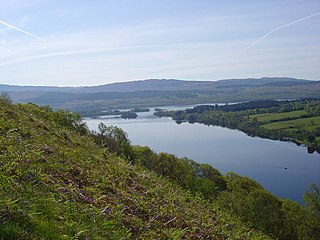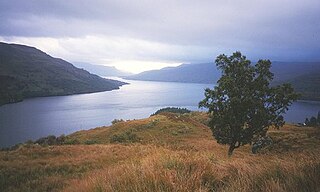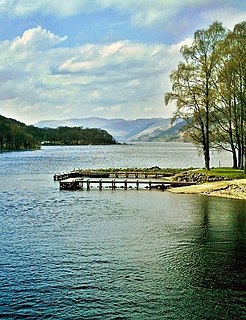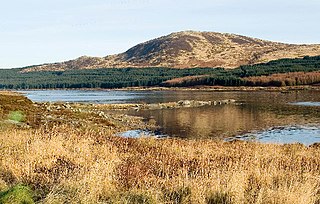This page is based on this
Wikipedia article Text is available under the
CC BY-SA 4.0 license; additional terms may apply.
Images, videos and audio are available under their respective licenses.

In Scottish folklore, the Loch Ness Monster or Nessie is a creature said to inhabit Loch Ness in the Scottish Highlands. It is often described as large in size with a long neck and one or more humps protruding from the water. Popular interest and belief in the creature has varied since it was brought to worldwide attention in 1933. Evidence of its existence is anecdotal, with a few disputed photographs and sonar readings.
Firth is a word in the Scots and English languages used to denote various coastal waters in Scotland and even a strait. In the Northern Isles, it more usually refers to a smaller inlet. It is linguistically cognate to fjord which has a more constrained sense in English. Bodies of water named "firths" tend to be more common on the east coast, or in the southwest of the country, although the Firth of Lorn is an exception to this. The Highland coast contains numerous estuaries, straits, and inlets of a similar kind, but not called "firth" ; instead, these are often called sea lochs. Before about 1850, the spelling "Frith" was more common.

Loch Lomond is a freshwater Scottish loch which crosses the Highland Boundary Fault, often considered the boundary between the lowlands of Central Scotland and the Highlands. Traditionally forming part of the boundary between the counties of Stirlingshire and Dunbartonshire, Loch Lomond is split between the council areas of Stirling, Argyll and Bute and West Dunbartonshire. Its southern shores are about 23 kilometres (14 mi) northwest of the centre of Glasgow, Scotland's largest city. The Loch forms part of the Loch Lomond and The Trossachs National Park which was established in 2002.

The Great Glen, also known as Glen Albyn or Glen More is a long and straight glen in Scotland running for 62 miles (100 km) from Inverness on the edge of Moray Firth, to Fort William at the head of Loch Linnhe.

Loch Awe is a large body of freshwater in Argyll and Bute, Scottish Highlands. It has also given its name to a village on its banks, variously known as Loch Awe, or Lochawe. There are islands within the loch such as Innis Chonnell and Inishail.

Loch Katrine is a freshwater loch and scenic attraction in the Trossachs area of the Scottish Highlands. It is within the district of Stirling. The loch is 13 kilometres (8.1 mi) long and 1 kilometre (0.62 mi) wide at the widest point and runs the length of Strath Gartney. It is a popular destination for tourists and day visitors from Glasgow and nearby towns.
The loch derives its name from the term cateran from the Gaelic ceathairne, a collective word meaning cattle thief or possibly peasantry. Historically this referred to a band of fighting men of a clan; hence the term applied to marauders or cattle-lifters, which Rob Roy MacGregor, a respectable cattle owner was erroneously accused of being.

Loch Leven is a fresh water loch located immediately to the east of the burgh of Kinross in Perth and Kinross council area, central Scotland. Roughly triangular, the loch is about 6 km (3.7 mi) at its longest. Prior to the canalisation of the River Leven, and the partial draining of the loch in 1826-36, Loch Leven was considerably larger. The drop in water level by 1.4 m reduced to the loch to 75% of its former size, and exposed several small islands, as well as greatly increasing the size of the existing ones.

Loch Maree is a loch in Wester Ross in the Northwest Highlands of Scotland. At 21.7 km (13.46 mi) long and with a maximum width of 4 km (2.5 mi), it is the fourth largest freshwater loch in Scotland; it is the largest north of Loch Ness. Its surface area is 28.7 km2 (11.08 sq mi).

Loch Lomond and The Trossachs National Park is a national park in Scotland centred on Loch Lomond and the hills and glens of the Trossachs, along with several other ranges of hills. It was the first of the two national parks established by the Scottish Parliament in 2002, the second being the Cairngorms National Park. The park consists of many mountains and lochs, and the principal attractions are scenery, walking, and wildlife.

Lake of Menteith, or Loch Inchmahome, is a loch in Scotland, located on the Carse of Stirling, the flood plain of the upper reaches of the rivers Forth and Teith, upstream of Stirling.

The each-uisge is a water spirit in Scottish folklore, known as the each-uisce in Ireland and cabyll-ushtey on the Isle of Man. It usually takes the form of a horse, and is similar to the kelpie but far more vicious.

Loch Earn is a freshwater loch in the central highlands of Scotland, in the districts of Perth and Kinross and Stirling.

Loch Doon is a freshwater loch in Carrick, Scotland. The River Doon issues from its northern end, while the loch itself receives waters from Loch Enoch via Eglin Lane.

A water horse is a mythical creature, such as the Ceffyl Dŵr, Capaill Uisce, the bäckahäst and kelpie.

Loch Ness is a large, deep, freshwater loch in the Scottish Highlands extending for approximately 37 kilometres southwest of Inverness. Its surface is 16 metres above sea level. Loch Ness is best known for alleged sightings of the cryptozoological Loch Ness Monster, also known affectionately as "Nessie". It is connected at the southern end by the River Oich and a section of the Caledonian Canal to Loch Oich. At the northern end there is the Bona Narrows which opens out into Loch Dochfour, which feeds the River Ness and a further section of canal to Inverness, ultimately leading to the North Sea via the Moray Firth. It is one of a series of interconnected, murky bodies of water in Scotland; its water visibility is exceptionally low due to a high peat content in the surrounding soil.













